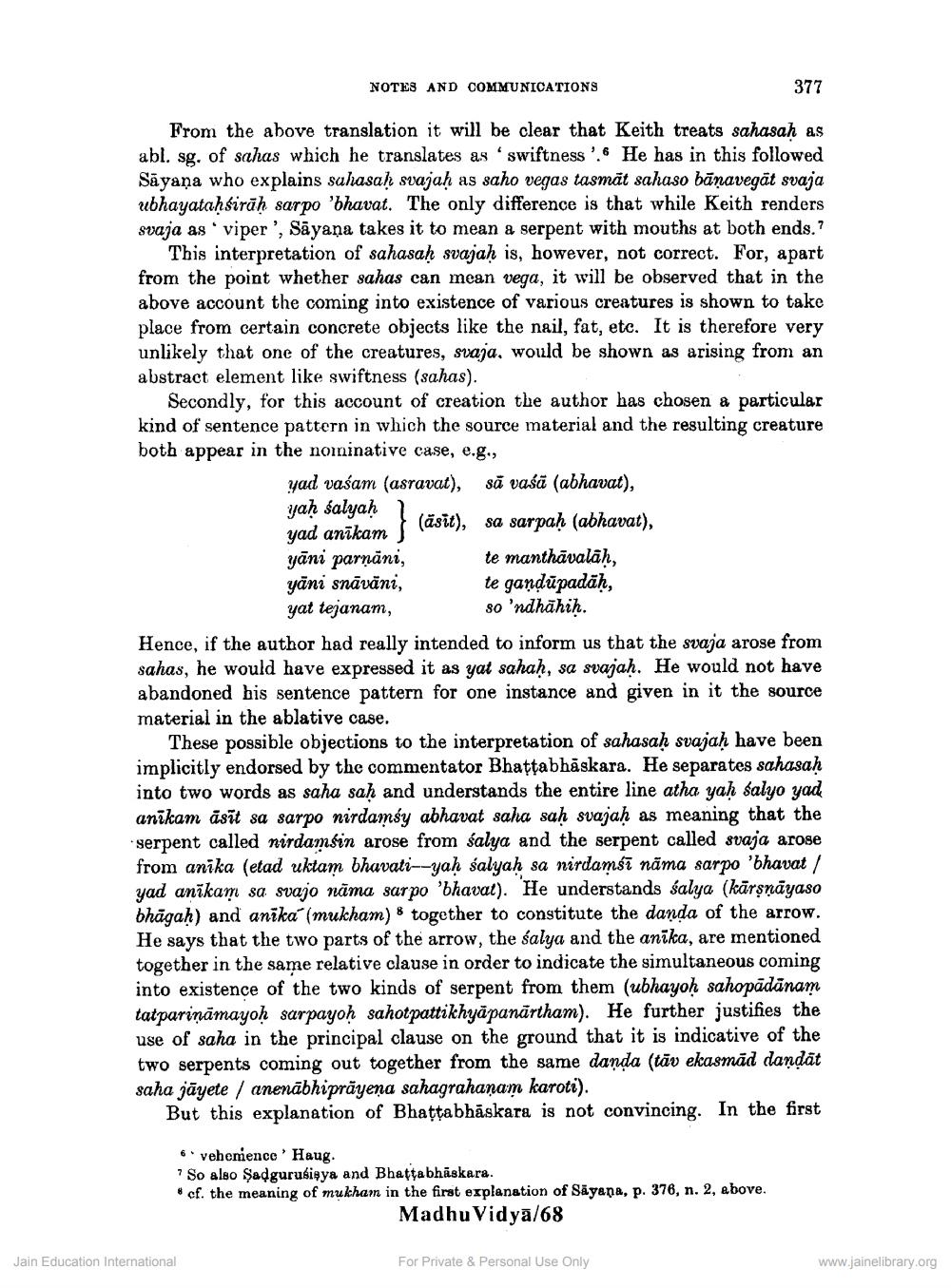________________
NOTES AND COMMUNICATIONS
377
From the above translation it will be clear that Keith treats sahasah as abl. sg. of sahas which he translates as 'swiftness'.. He has in this followed Sāyaṇa who explains sahasah svajah as saho vegas tasmāt sahaso bānavegāt svaja ubhayataḥ śirāḥ sarpo 'bhavat. The only difference is that while Keith renders svaja as viper', Sāyana takes it to mean a serpent with mouths at both ends.?
This interpretation of sahasaḥ svajah is, however, not correct. For, apart from the point whether sahas can mean vega, it will be observed that in the above account the coming into existence of various creatures is shown to take place from certain concrete objects like the nail, fat, etc. It is therefore very unlikely that one of the creatures, svaja, would be shown as arising from an abstract element like swiftness (sahas).
Secondly, for this account of creation the author has chosen & particular kind of sentence pattern in which the source material and the resulting creature both appear in the nominative case, e.g.,
yad vašam (astavat), să vaśā (abhavat), yaḥ śalyah
} (äsit), sa sarpah (abhavat), yad anīkam yāni parnāni, te manthāvalah, yāni snāvāni, te gandūpadāh, yat tejanam,
so 'ndhāhih. Hence, if the author had really intended to inform us that the svaja arose from sahas, he would have expressed it as yat sahaḥ, sa svajah. He would not have abandoned his sentence pattern for one instance and given in it the source material in the ablative case.
These possible objections to the interpretation of sahasah svajah have been implicitly endorsed by the commentator Bhattabhāskara. He separates sahasaḥ into two words as saha saḥ and understands the entire line atha yah salyo yad anikam āsīt sa sarpo nirdamsy abhavat saha saḥ svajaḥ as meaning that the serpent called nirdamsin arose from salya and the serpent called svaja arose from anika (etad uktam bhavati--yaḥ salyah sa nirdamśī nāma sarpo 'bhavat / yad anikam sa svajo nāma sarpo 'bhavat). He understands salya (kārşnāyaso bhāgah) and anika (mukham) * together to constitute the danda of the arrow. He says that the two parts of the arrow, the salya and the anika, are mentioned together in the same relative clause in order to indicate the simultaneous coming into existence of the two kinds of serpent from them (ubhayoḥ sahopādānam tatparināmayoḥ sarpayoh sahotpattikhyāpanārtham). He further justifies the use of saha in the principal clause on the ground that it is indicative of the two serpents coming out together from the same danda (tāv ekasmäd dandát saha jāyete / anenābhiprāyena sahagrahanam karoti).
But this explanation of Bhattabhāskara is not convincing. In the first
6. vehemence' Haug.
So also Sadgurusisya and Bhattabhāskara. & cf. the meaning of mukham in the first explanation of Säyana, p. 376, n. 2, above.
Madhu Vidyā/68
Jain Education International
For Private & Personal Use Only
www.jainelibrary.org




